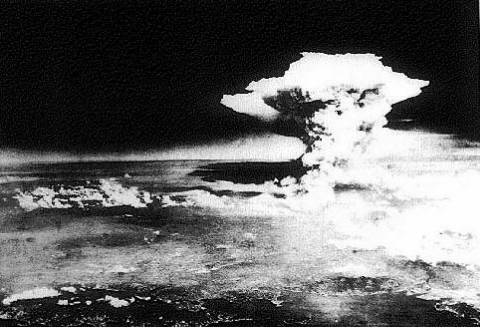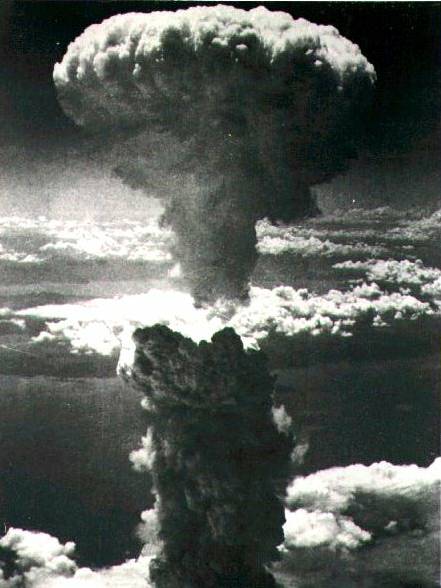

Operation IVY 1952.
Operation Ivy was the eighth series of American nuclear tests coming after Tumbler-Snapper and before Upshot-Knothole. The purpose of the tests was to help upgrade the U.S. arsenal of nuclear weapons in response to the Soviet nuclear weapons program. The two explosions were staged in late 1952 at the Pacific Proving Ground in the Marshall Islands.
The first device codenamed Mike was notable for being the first successful test of a multi-megaton thermonuclear weapon design (the Teller-Ulam design) usually considered the world's first hydrogen bomb test. It used liquid deuterium as its fusion fuel kept cold with an expensive and cumbersome cryogenic system. Too unwieldy to be deployed as a weapon it was built to demonstrate the power and possibility of using nuclear fusion as a principle for larger-yield nuclear weapons than previously possible. It was detonated on Elugelab Island in the Enewetak atoll of the Marshall Islands. It yielded 10.4 megatons of explosive power almost 500 times the power of the bomb that was dropped on Nagasaki. 8 megatons of the yield was from fast fission of the uranium tamper. The detonation obliterated Elugelab leaving an underwater crater 6240 ft (1.9 km) wide and 164 ft (50 m) deep where an island had once been.
The second test King was a test of the largest nuclear weapon ever built at the time which utilized only nuclear fission as the source of its energy (it had none of its energy added from fusion or fusion boosting). It was dubbed the "Super Oralloy Bomb" and was intended as a backup if the fusion weapon was a failure. It had a yield of 500 kilotons 25-40 times more powerful than the weapons dropped during World War II. Total Runtime Appx. 62 minutes.
Military Participation on TUMBLER-SNAPPER 1952.
Operation Tumbler-Snapper was a series of atomic tests conducted by the United States in the spring of 1952 at the Nevada Test Site. The Tumbler-Snapper Series of tests preceded Operation Ivy and followed Operation Buster-Jangle.
The Tumbler phase consisted of four daytime airdrops which were intended to help explain discrepancies in the actual and estimated blast shock wave damage noted on previous detonations and to establish more accurately the optimum height of burst.
The Snapper phase consisted of 4 tower shots fired during the nighttime on the 7th and 25th of May and the 1st and 5th of June. Total Runtime Appx. 47 minutes.
The 280 mm Gun at the Nevada Proving Ground 1953.
The Grable Event part of Operation Upshot-Knothole was a test of a 15-kiloton atomic artillery shell fired from a 280-mm cannon on May 25 1953 at the Nevada Proving Grounds.
The testing of the Mark 9 atomic artillery shell was the Grable event part of a much larger series of nuclear detonations under the umbrella of Operation UPSHOT-KNOTHOLE in 1953. Total Runtime Appx. 11 minutes.
Operation UPSHOT-KNOTHOLE 1953.
Operation Upshot-Knothole was a series of eleven nuclear test shots conducted in 1953 at the Nevada Test Site.
Over twenty-one thousand soldiers took part in the ground exercise Desert Rock V in conjunction with the Grable shot. Grable was a 280mm shell fired from the “Atomic Cannon” and was viewed by a number of high-ranking military officials.
Operation Upshot-Knothole followed Operation Ivy and preceded Operation Castle. The test series was notable as containing the first time an atomic artillery shell was fired (Shot Grable) the first two shots (both fizzles) by University of California Radiation Laboratory—Livermore (now Lawrence Livermore National Laboratory) and for testing out some of the thermonuclear components that would be used for the massive thermonuclear series of Operation Castle. Total Runtime Appx. 35 minutes.
Operation CASTLE Commander's Report 1954.
Operation Castle was a United States series of high-energy (high-yield) nuclear tests by Joint Task Force SEVEN (JTF-7) at Bikini Atoll beginning in March 1954. It followed Operation Upshot-Knothole and preceded Operation Teapot.
Conducted as a joint venture between the Atomic Energy Commission (AEC) and the Department of Defense (DoD) the ultimate objective of the operation was to test designs for an aircraft-deliverable thermonuclear weapon.
Operation Castle is (largely) considered to be a success for the "dry fuel" design. One device failed to produce its predicted yield. Two other devices detonated with over twice their predicted yields. One test in particular Castle Bravo resulted in extensive radiological contamination of nearby islands (including inhabitants and U.S. soldiers stationed there) as well as a nearby Japanese fishing boat resulting in one direct fatality and continued health problems for many of those exposed. Public reaction to the tests and an awareness of the long-range effects of nuclear fallout has been attributed as being part of the motivation for the Partial Test Ban Treaty of 1963. Total Runtime Appx. 20 minutes.
Operation CASTLE Military Effects Studies 1954.
Operation Castle was a United States series of high-energy (high-yield) nuclear tests by Joint Task Force SEVEN (JTF-7) at Bikini Atoll beginning in March 1954. It followed Operation Upshot-Knothole and preceded Operation Teapot.
Conducted as a joint venture between the Atomic Energy Commission (AEC) and the Department of Defense (DoD) the ultimate objective of the operation was to test designs for an aircraft-deliverable thermonuclear weapon.
Operation Castle is (largely) considered to be a success for the "dry fuel" design. One device failed to produce its predicted yield. Two other devices detonated with over twice their predicted yields. One test in particular Castle Bravo resulted in extensive radiological contamination of nearby islands (including inhabitants and U.S. soldiers stationed there) as well as a nearby Japanese fishing boat resulting in one direct fatality and continued health problems for many of those exposed. Public reaction to the tests and an awareness of the long-range effects of nuclear fallout has been attributed as being part of the motivation for the Partial Test Ban Treaty of 1963. Total Runtime Appx. 39 minutes.

